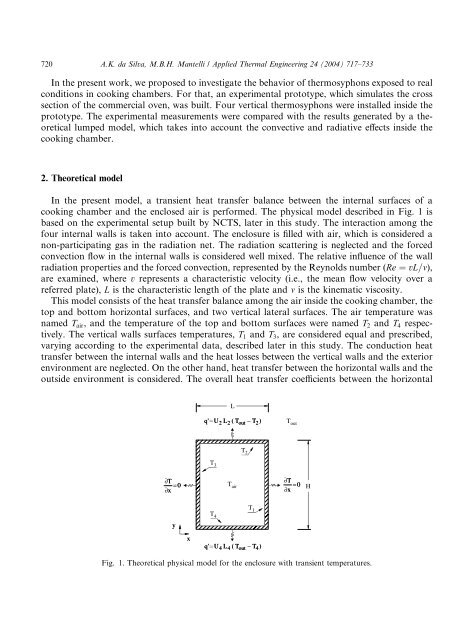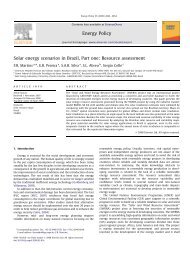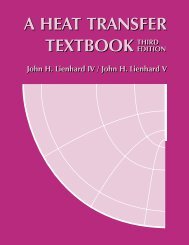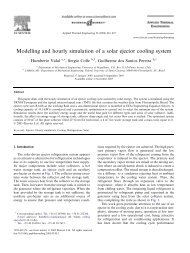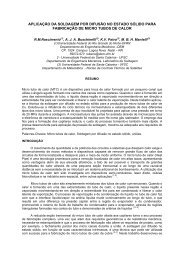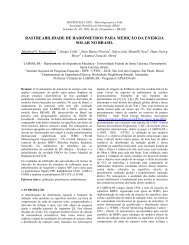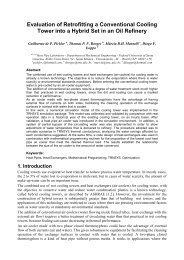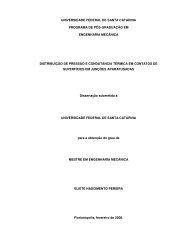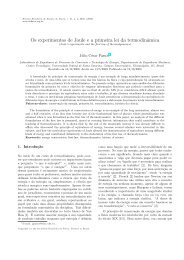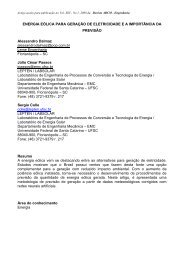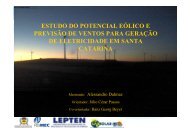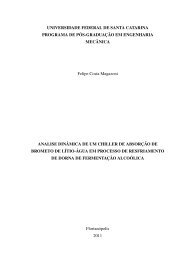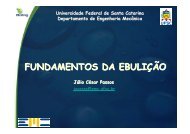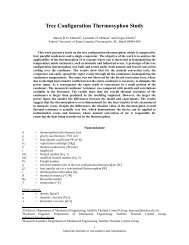Thermal applicability of two-phase thermosyphons in ... - LEPTEN
Thermal applicability of two-phase thermosyphons in ... - LEPTEN
Thermal applicability of two-phase thermosyphons in ... - LEPTEN
Create successful ePaper yourself
Turn your PDF publications into a flip-book with our unique Google optimized e-Paper software.
720 A.K. da Silva, M.B.H. Mantelli / Applied <strong>Thermal</strong> Eng<strong>in</strong>eer<strong>in</strong>g 24 (2004) 717–733In the present work, we proposed to <strong>in</strong>vestigate the behavior <strong>of</strong> <strong>thermosyphons</strong> exposed to realconditions <strong>in</strong> cook<strong>in</strong>g chambers. For that, an experimental prototype, which simulates the crosssection <strong>of</strong> the commercial oven, was built. Four vertical <strong>thermosyphons</strong> were <strong>in</strong>stalled <strong>in</strong>side theprototype. The experimental measurements were compared with the results generated by a theoreticallumped model, which takes <strong>in</strong>to account the convective and radiative effects <strong>in</strong>side thecook<strong>in</strong>g chamber.2. Theoretical modelIn the present model, a transient heat transfer balance between the <strong>in</strong>ternal surfaces <strong>of</strong> acook<strong>in</strong>g chamber and the enclosed air is performed. The physical model described <strong>in</strong> Fig. 1 isbased on the experimental setup built by NCTS, later <strong>in</strong> this study. The <strong>in</strong>teraction among thefour <strong>in</strong>ternal walls is taken <strong>in</strong>to account. The enclosure is filled with air, which is considered anon-participat<strong>in</strong>g gas <strong>in</strong> the radiation net. The radiation scatter<strong>in</strong>g is neglected and the forcedconvection flow <strong>in</strong> the <strong>in</strong>ternal walls is considered well mixed. The relative <strong>in</strong>fluence <strong>of</strong> the wallradiation properties and the forced convection, represented by the Reynolds number (Re ¼ vL=m),are exam<strong>in</strong>ed, where v represents a characteristic velocity (i.e., the mean flow velocity over areferred plate), L is the characteristic length <strong>of</strong> the plate and m is the k<strong>in</strong>ematic viscosity.This model consists <strong>of</strong> the heat transfer balance among the air <strong>in</strong>side the cook<strong>in</strong>g chamber, thetop and bottom horizontal surfaces, and <strong>two</strong> vertical lateral surfaces. The air temperature wasnamed T air , and the temperature <strong>of</strong> the top and bottom surfaces were named T 2 and T 4 respectively.The vertical walls surfaces temperatures, T 1 and T 3 , are considered equal and prescribed,vary<strong>in</strong>g accord<strong>in</strong>g to the experimental data, described later <strong>in</strong> this study. The conduction heattransfer between the <strong>in</strong>ternal walls and the heat losses between the vertical walls and the exteriorenvironment are neglected. On the other hand, heat transfer between the horizontal walls and theoutside environment is considered. The overall heat transfer coefficients between the horizontalLq' U2L2(ToutT2)T 3T 2∂T ∂T = 0= 0∂x∂xT 1yT 4T airT outHxq' U4L4(ToutT4)Fig. 1. Theoretical physical model for the enclosure with transient temperatures.


